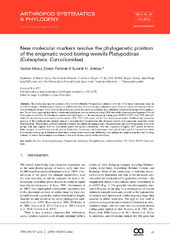New molecular markers resolve the phylogenetic position of the enigmatic wood-boring weevils Platypodinae (Coleoptera: Curculionidae)
Peer reviewed, Journal article
Published version

Åpne
Permanent lenke
https://hdl.handle.net/1956/23599Utgivelsesdato
2018Metadata
Vis full innførselSamlinger
Sammendrag
The precise phylogenetic position of the weevil subfamily Platypodinae continues to be one of the more contentious issues in weevil systematics. Morphological features of adult beetles and similar ecological adaptations point towards a close relationship with the wood boring Scolytinae, while some recent molecular studies and larval morphology have indicated a closer relationship to Dryophthorinae. To test these opposing hypotheses, a molecular phylogeny was reconstructed using 5,966 nucleotides from ten gene fragments. Five of these genes are used for the first time to explore beetle phylogeny, i.e. the nuclear protein coding genes PABP1, UBA5, Arr2, TPI, and Iap2, while five markers have been used in earlier studies (28S, COI, CAD, ArgK, and EF-1α). Bayesian, maximum likelihood and parsimony analyses of the combined data strongly support a monophyletic Curculionidae (the advanced weevils with geniculate antennae), where Brachycerinae, Platypodinae, and Dryophthorinae formed the earliest diverging groups. Dryophthorinae and core Platypodinae were sister groups with high support, with the contentious genera Mecopelmus Blackman, 1944 and Coptonotus Chapuis, 1873 placed elsewhere. Other lineages of wood boring weevils such as Scolytinae, Cossoninae, and Conoderinae were part of a derived, but less resolved, clade forming the sister group to Entiminae. Resolution among major curculionid subfamilies was ambiguous, emphasizing the need for large volumes of data to further improve resolution in this most diverse section of the weevil tree.